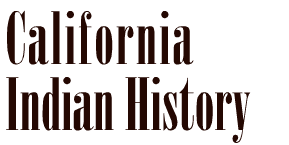About the California Indian History Timelines
The annotated California Indian History timelines and primary source materials document federal, state and local government officials’ intentional denial of resources and lands for Indigenous California Nations to survive culturally and economically. The timelines bear witness to the long-term, widespread, and systematic violence perpetrated by Euro-Americans against California’s Indigenous People prior to statehood from the late 1840s into the late nineteenth century. The primary source documents and related materials included on the timelines evidence how in one far western state Euro-American ‘militias,’ and organized companies of local citizens supported by the State of California acted as political and social institutions to attempt to systematically destroy the Indigenous People whose ancestral lands are now known as California. The rosters created and included on the timelines (1854-1864) compiled from official state records show at least 4,899 names attached to fifty-four militia or independent company units supported by the Governor, the Legislature and the Adjutant General. The nineteenth century newspaper accounts collected from statewide publications reveal violent activities against California Indians across California.
California Indian History Timelines Historical Research Methods
The historical research methods utilized for the California Indian History website timelines were first developed from 2003 – 2006, during the creation and production of the California State Library’s California Indians Historical Resources Project (CIHRP), and then built upon during completion of Kimberly Johnston-Dodds’ graduate thesis project in Public History at Sacramento State in 2009. The methods used for this website to review and include primary source materials documenting Euro-American violence against California Indians are similar to that employed for the CIHRP.
The CIHRP project entailed historical research, digitization of primary historical documents located in California State Library collections, and the creation of a related searchable database. The procedure to create the CIHRP used rigorous historical research methodology and quality control to ensure that the correct citation for each document was included in the database fields.
Research staff first conducted an extensive review of published secondary source materials related to California Indian history and government relations. Next, project staff reviewed microfilm and original copies of nineteenth century newspaper articles, federal government and state legislative materials located in the California History Section and Government Publications Section of the California State Library. Relevant documents were copied, digitally scanned, and indexed for inclusion in the project. Copies scanned from poor quality original microfilm were digitally processed, when possible, to try to improve legibility without affecting the integrity of content. These efforts resulted in the production of three CDs that contained digitized images of the documents, with bibliographic information in a searchable database based on each document type (newspaper, state, and federal). Copies of the CIHRP CDs were provided to California Tribes and county public libraries during the summer and fall of 2008.
For the California Indian History website timelines, the methods used to locate references to primary source materials documenting Euro-American violence against California Indians are similar to that employed for the CIHRP. We conduct extensive reviews of published and unpublished primary and secondary sources located in a variety of repositories throughout California counties. The types of repositories visited range from county archives and historical societies to museums, public libraries, California State Archives and other state and federal agencies’ historical collections. Examples of the types of materials reviewed in all repositories include unpublished manuscript collections, dissertations, masters’ theses, national and state park historical reports, and published works such as books, historical society journal articles and publications.
For more information about the timelines methodology, thesis project, and related bibliography, click here.
